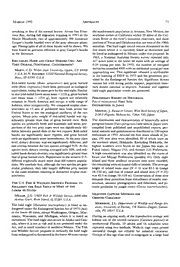
Red-tailed hawk and great horned owl: Are they diurnal/nocturnal counterparts? PDF
Preview Red-tailed hawk and great horned owl: Are they diurnal/nocturnal counterparts?
March 1995 Abstracts 71 streaking in lieu of the normal brown. Across San Fran- the southwestern population in Arizona, New Mexico, the cisco Bay, during fall migration trapping in 1993 in the southeast corner of California within 10 miles of the Col- Marin Headlands, two of approximately 500 immature orado River or the river’s mainstem reservoirs, and those Cooper’s hawks banded were of the gray aberrant plum- portions ofTexas and Oklahoma that are west ofthe 100th age. Photographs of all of these hawks will be shown. We meridian. The bald eagle would remain threatened in the have found no previous reference to gray Cooper’s hawks five states where it is currently listed as threatened and in the literature. be listed as endangered in Mexico under this proposal. In 1963, a National Audubon Society survey reported only Red-tailed Hawk and Great Horned Owl; Are 417 active nests in the lower 48 states with an average of They Diurnal/Nocturnal Counterparts? 0.59 young per nest. In 1993, the number of occupied UT territories exceeded 4000 with an estimated young per nest Marti, C.D, Weber State University, Ogden, 84408 U.S.A. M.N. Kochert. USDINationalBiologicalSurvey, approaching one. TDhiDsTsignificant rebound is attributable to the banning of in 1972 and the protection pro- Boise, ID 83705 U.S.A. vided by the Endangered Species Act. Significant threats Red-tailed hawks {Buteo jamaicensis) and great horned remain but with strong public support, population num- owls {Bubo virginianus) have been portrayed as ecological bers should continue to improve. National and regional equivalents, eatingthe same prey by dayand night. Similar bald eagle population trends are presented. in size (red-tailed hawk mean mass = 1126 g, great horned owl mean mass — 1354 both raptors are relatively Preliminary Report on Historical g), common in North America and occupy a wide range of Falco peregrinus Nest Site We habitats, often sympatrically. compared trophic char- Distribution in Japan acteristics in 13 sets of published data from across the United States to test the ecological similarity of the two Minton, J. Research Center, Wild BirdSociety ofJapan, species. Mean prey weight of red-tailed hawks was sig- 2-24-5 Higashi, Shibuya-ku, Tokyo 150, Japan nificantly greater than that of great horned owls. Both The distribution and characteristics of historically active species ate primarily birds and mammals and mean pro- peregrine falcon {Falcoperegrinus) nest sites inJapan were portions of the two prey types were not significantly dif- compiled from published and unpublished reports, per- ferent between paired diets of the two raptors. Red-tailed sonal contacts and questionnaires distributed to 120 raptor hawks ate significantly more reptiles, and great horned enthusiasts in 1993. Around the four main islands of Ja- owls ate significantly more invertebrates. At the prey class pan, 191 nest sites were identified, 80 of which were on level, dietary diversity was not significantly different, and the northern island, Hokkaido. Excluding Hokkaido, the diet overlap between the two species averaged 91%. At the highest numbers were found on the Japan Sea coast, in species level, dietary overlap averaged only 50%, and red- Fukui (nine), Niigata (10), and Aomori (13) Prefectures. tailed hawk dietary diversity was significantly greaterthan A high concentration was also identified on the coasts of that ofgreat horned owls. Populations in the western U.S. Iwate and Miyagi Prefectures (possibly 41). Only eight differed trophically much more than did eastern popula- inland and three artificial structure sites were recorded, tions. We conclude that, although the two species are gen- theremaining wereon coastal cliffsorislands. The average = m eralist predators, they take largely different prey species height of inland nests sites {N 5) was 83.5 (range = in the same localities resulting in distinctive trophic char- 18-150 m), and that of coastal and island sites {N 22) m acteristics. was 43.5 (range 10-110 m). Conservation of these sites demands their protection from disturbance of nearby con- The U.S. Fish & Wildlife Service’s Proposal to struction, amateur photographers and fishermen, and ju- Reclassify the Bald Eagle in Most of the venile predation by jungle crows {Corvus macrorhynchos). Lower 48 States Selective Capture Methods for Millar, J.G. USDI Fish ir Wildlife Service, 4469-48th Crested Caracaras Avenue Court, Rock Island, IL 61201 U.S.A. The bald eagle {Haliaeetus leucocephalus) is listed as en- Morrison, J.L. Department of Wildlife and Range Sci- ences, University ofFlorida, 118 Nevuins-Ziegler, Gaines- dangered under the Endangered Species Act of 1973 (Act) ville, FL 32611 U.S.A. in the lower 48 states, except Washington, Oregon, Min- nesota, Wisconsin, and Michigan, where it is listed as During an ongoing study of the reproductive ecology and threatened. The bald eagle also occurs in Alaska and Can- habitat use of the crested caracara {Caracara plancus) in ada, where it is not at risk and is not protected under the southcentral Florida, 10 adults and 16 subadults were Act; and in small numbers in northern Mexico. The Fish captured using two methods. Walk-in cage traps proved and Wildlife Service proposes to reclassify the bald eagle successful though not reliable for subadult caracaras. from endangeredtothreatened in thelower48 statesexcept Groups of this age class tend to congregate at a large food
